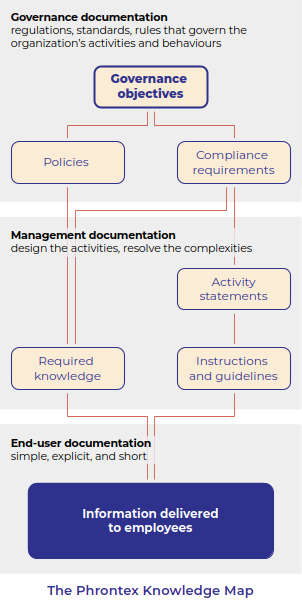White paperCorporate governance systems
An effective, economical solution to the practical challenges of good governance
The practical challenges of corporate governance
In all but the simplest organizations, achieving good governance presents challenges.
- The work is inherently complex, involving a large number of interrelated items of knowledge across the entire organization: compliance requirements, policies, procedures, controls, training and communication requirements.
- There is continual change within the organization: new systems, improved procedures, new suppliers and customers and contracts, turnover of personnel.
- The organization operates in a complex landscape of shifting regulations (often across multiple jurisdictions), investor demands, contractual requirements, and community expectations.
The organization must not only achieve good governance, it must also be able to prove it.
- The organization’s governance system, as a presentable body of knowledge, is its first line of defence in the event of a compliance failure. Penalties for compliance failure can be severe, including fines and prison time for directors and officers.
- As a supplier, the organization may be required to demonstrate good governance to meet contractual obligations and satisfy customers’ supply chain due diligence requirements.
- Directors have a duty to oversee the organization’s activities including compliance with statutory obligations. The governance system should make exercising this oversight straightforward.
‘Traditional documentation’ — PDFs, spreadsheets, shared drives — is not fit for purpose when it comes to corporate governance: the body of knowledge is too complex and constantly changing. Confidence in completeness and consistency is impossible.
A Phrontex corporate governance system is a methodology for organizing, maintaining, and controlling the items of knowledge on which your corporate governance relies. It is fast, efficient, and effective, enabling compliance with less effort and lower cost.
The documentation problem
Corporate governance has to be documented as a single body of knowledge. You must see the mapping from compliance requirements to policies and procedures, and be confident everything remains consistent.
This just can’t be done with separate documents.
Corporate knowledge maintained in a set of documents will always have overlaps, gaps, contradictions, and outdated content. On average, 65 percent of documentation in established organizations is obsolete, duplicated, or irrelevant.
Traditional documentation is expensive
- Every document took management or consultant time to create; older documents may have lost value.
- More documents increase the time spent finding information, raising the likelihood of error.
- Induction, training, and audit effort correlates with the quantity and quality of documentation.
Documentation is a point of risk
- Incorrect, incomplete, or obsolete documentation increases risk.
- Failure to communicate documentation to employees creates further exposure.
Governance requires a single source of truth
An organization has multiple activities, objectives, and compliance obligations. The challenge is to give your people an integrated body of knowledge defining governance objectives, responsibilities, and activities.
- Directors see compliance requirements and corresponding policies, procedures, training.
- Managers see relevant compliance for each activity.
- Employees access information necessary for their work safely and legally.
- Trainers/HR understand knowledge requirements per role.

Line-of-sight governance
Directors and officers need to see that the organization meets its obligations.
A corporate governance system makes this straightforward:
Case learnings
From NHVR prosecutions, 2024
- Ensure employees are trained for compliance.
- Provide adequate information, training, and supervision.
- Implement and monitor systems and processes to ensure adherence.
- Review policies and procedures regularly.
The Phrontex implementation project
The project creates and implements a corporate governance system in your organization.
Many elements already exist but are spread across multiple stores, poorly documented, communicated, and managed.
Phrontex consolidates these elements into a single, integrated, maintainable system.
Objectives
- Ensure regulatory and compliance obligations are met.
- Standardize, simplify, and minimize governance systems so good governance is built into routine activities.
Outcomes
- A structured knowledge base of policies, procedures, and registers.
- Procedures for validating and verifying the governance system.
- Skills transfer for in-house maintenance and improvement.
- Communications and awareness program for rollout and implementation.
Return on investment
- Reduced compliance failure risk
- Improved knowledge management
- Faster decision implementation
- Simplified oversight and audit
- Lower maintenance and implementation effort
Corporate governance isn’t optional. Phrontex is a better way to achieve it.

